The Nones Project: Zealous Atheists
So far, we’ve laid out three types of non-religious Americans.
Nones in Name Only (NiNos). These are folks who score relatively high on metrics like religious attendance and prayer frequency. But they just don’t want to identify with a religious tradition.
Spiritual but not Religious (SBNRs). This is one that you can pretty much figure out from the title. They score high on measures related to New Age spirituality but they strongly reject traditional religious labels and practices.
The Dones. These folks who just don’t yearn for God; they don’t pray at all; they don’t attend a house of worship, ever. The vast majority don’t believe in an afterlife. They are, quite literally, done with religion in almost every conceivable way.
But there’s one more group in our typology that seems to raise the most eyebrows and get the most head nods when we discuss this stuff during a presentation. This fourth category only makes up 11% of all nones, but I think we all have had an interaction or two with them. We have decided to call them the Zealous Atheists.
We Asked the Nones a Bunch of Questions About Leaving Religion
More information about the Freedom from Religion Foundation can be found here. You can join their organization by following this link. Or you can simply make a donation via this link.
Their defining characteristic was uncovered in a single question we asked to all the non-religious respondents in the survey, “How many instances can you recall in the last 12 months in which you have tried to convince someone to disaffiliate from religion?” We gave them response options that ranged from never to more than 10 times. But in reality, we could have just made it much simpler: yes or no.
We found that just about 10% of the nones had tried to convince someone to leave religion behind in the prior year. I think it’s fair to say that there’s not a huge horde of atheists out there who are trying to convince college students to start reading Nietzsche. But that one question became a keyhole in sorting out the nones.
While just one in ten nones has tried to be evangelical about their non-religion in the prior year, it was more than three quarters of one of our clusters. For reasons that the algorithm doesn’t explain, it decided that this one variable was incredibly helpful in classifying the nones. That’s where we get the Zealous Atheists from. As previously noted, they are easily the smallest group, just 11% of all non-religious folks. But boy do they make a lot of noise online.
Let’s begin explaining this group by visualizing where they fit in two dimensional space on measures of spiritual and religious importance.
As mentioned in prior posts, the NiNos are in the top right of the heatmap. They score pretty high on both measures of importance. In contrast, the SBNRs are exactly where you would expect: high on spirituality and low on religion. And you can probably guess where the Dones find themselves, very low on both dimensions.
Where do the Zealous Atheists show up? That’s a bit harder to describe. They are certainly in the lower left corner (low on spirituality and low on religiosity), but they aren’t highly concentrated like the Dones. Thirty percent of ZAs say “not at all” on both dimensions, but that’s significantly lower than the Dones. Instead, you can find pockets of ZAs all over the heatmap. For instance, about 10% of them say that both religion and spirituality are “not too important”. But the same share says that both are “somewhat” important.
This may seem counterintuitive, but it looks like the Zealous Atheists are not as done with religion as the Dones. That’s a key throughline in our data. Take a look at religious attendance among the four types of nones.
As you can probably guess, NiNos are the most likely to attend religious services on a semi-regular basis. The Dones however are basically never there — 99% attend seldom or never. But look at those Zealous Atheists — there’s a decent chunk of them who actually do attend a house of worship a little bit. While 60% are never-attenders and 23% report their attendance as seldom, that means that almost one-in-five are going once a year.
What’s wild is that this is the second-highest level of religious attendance of any of the four types of nones. This is a key insight into the makeup of the Zealous Atheists. They aren’t quite “done” with religion just yet.
That point is driven home when you take a look at a question about frequency of prayer. Yes, a majority of the Zealous Atheists don’t pray at all (56%), but that’s still 32 points lower than among the Dones. There’s clearly a gap between those two groups. In fact, about 12% of Zealous Atheists indicate that they pray a little bit.
I don’t want to lay too much of a narrative on the data, but I’ve poked around these survey results a lot over the last couple of months, and what I see time and time again is that the Dones and the Zealous Atheists represent two sides of the same coin. Both groups are clearly antagonistic toward religion and religious people. But they take a totally different approach to things.
Dones just don’t care anymore. At one point they may have been up for a spirited debate about the existence of God or the value of religion. But they just don’t seem to want to fight those battles now. There’s a moment during the research process we wanted to call them “Laissez-faire nones” because their whole approach seems to be: live and let live, but leave me out of it.
On the other hand, the Zealous Atheists are still gearing up for battle on a regular basis. They want to try and change hearts and minds about religion. And the data about religious attendance and prayer frequency tells us that they are still interacting with religion just enough to know that they don’t like it that much at all. They need those ‘friction points’ to remind them why they are so opposed to religion.
All this came into really sharp focus for me when I was messing around with demographic variables. I did a quick calculation of the age distribution of each of the four types of nones and I had a “eureka” moment.
Guess what category of nones is the youngest? Yup, it’s the Zealous Atheists. In fact, 70% of them are between the ages of 18 and 45. Nearly half of them are no older than 35 years old and only 12% are of retirement age. When you compare those figures to the Dones, you can see a clear divide.
How Do Organized Nones Differ from All Nones?
More information about the Freedom From Religion Foundation can be found here. You can join their organization by following this link. Or you can simply make a donation via this link.
About one third of all Dones are at least 65 years old, and only 24% are between the ages of 18 and 35. In other words, these two categories represent entirely different generations of non-religion in the United States. The Dones are worn out from all the fights about religion. They’ve tried to evangelize their Christian friends to leave church behind. But they just sit back and shake their heads now.
On the other hand, the Zealous Atheists still have a fire in their belly to try and change the world. In a talk once I referred to them as the “Reddit Atheists.” And that got a huge response. These are the kinds of folks who use mocking terms like “Sky Daddy” and assert their moral superiority because they “don’t have to believe in fairy tales to be a good person.” I think we’ve all seen this type of discourse play out on one social media site or another.
But I think this is a great example of a scenario where the loudest voices in a group do not represent the average member. Remember, just 11% of all nones are Zealous Atheists. If you do the math, it means that only 3% of Americans fall into this category. But they seem to take up all the oxygen in the room in debates about religion.
The silent majority of nones just don’t seem to be so angry about religion. That’s a point we are going to drive home in future posts on The Nones Project. In fact, a whole bunch of nones seem to feel slightly positive toward religion and religious groups. It’s just the loudest voices who get all the retweets and shares.
Code for this post can be found here.
Ryan P. Burge is a professor of practice at the Danforth Center on Religion and Politics at Washington University.





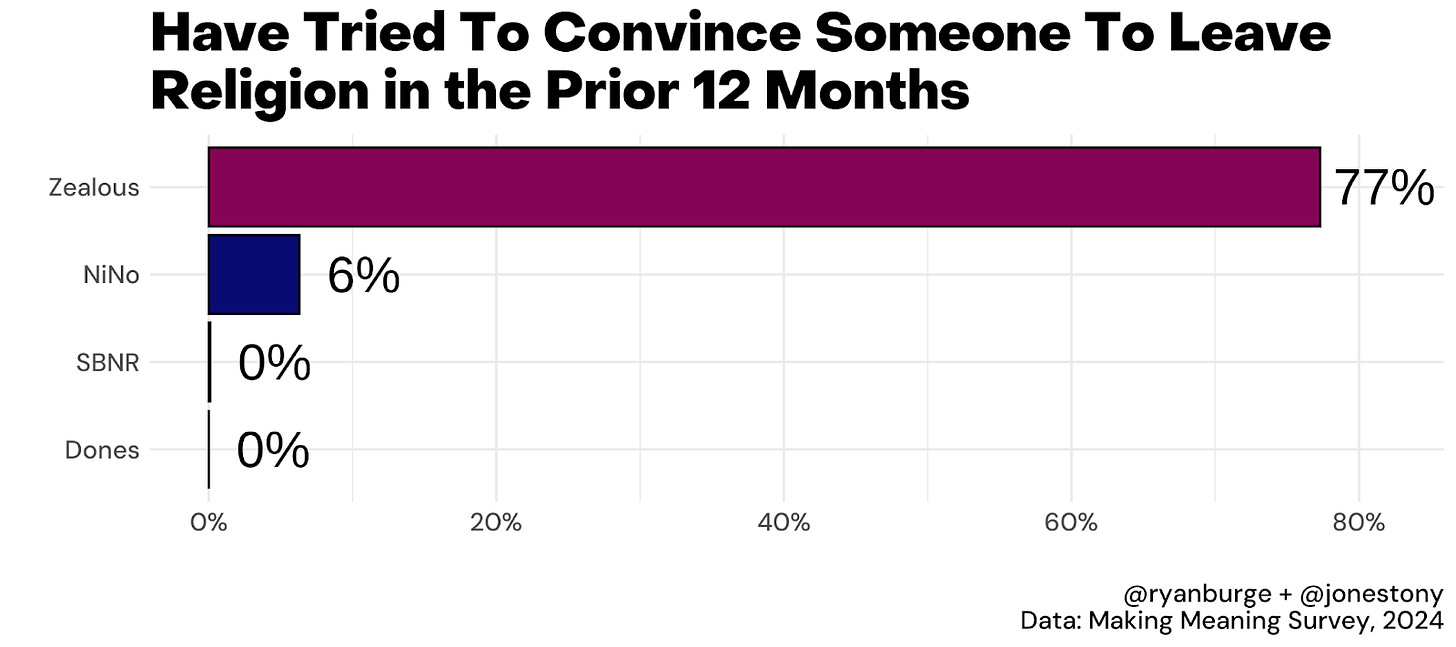
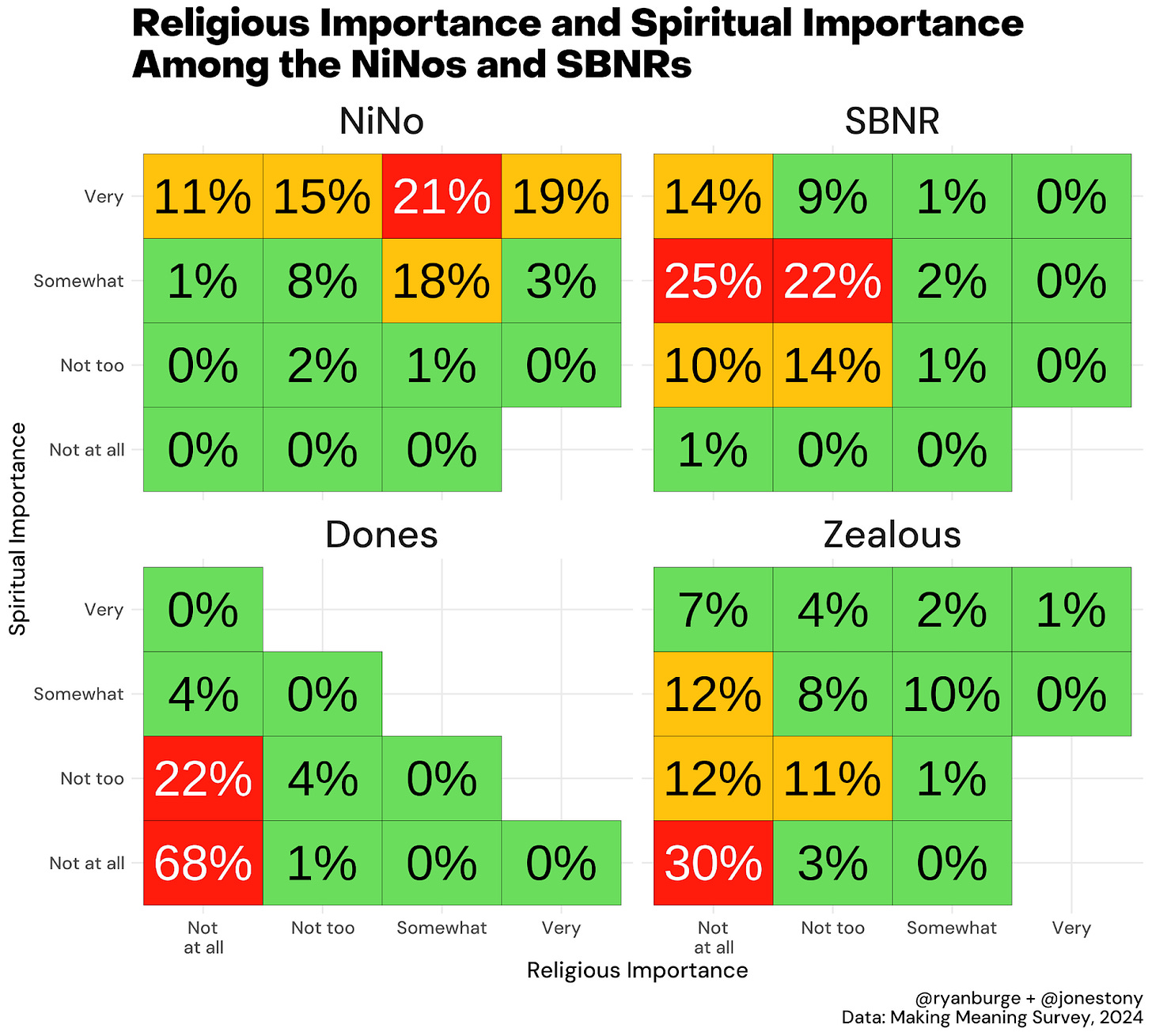
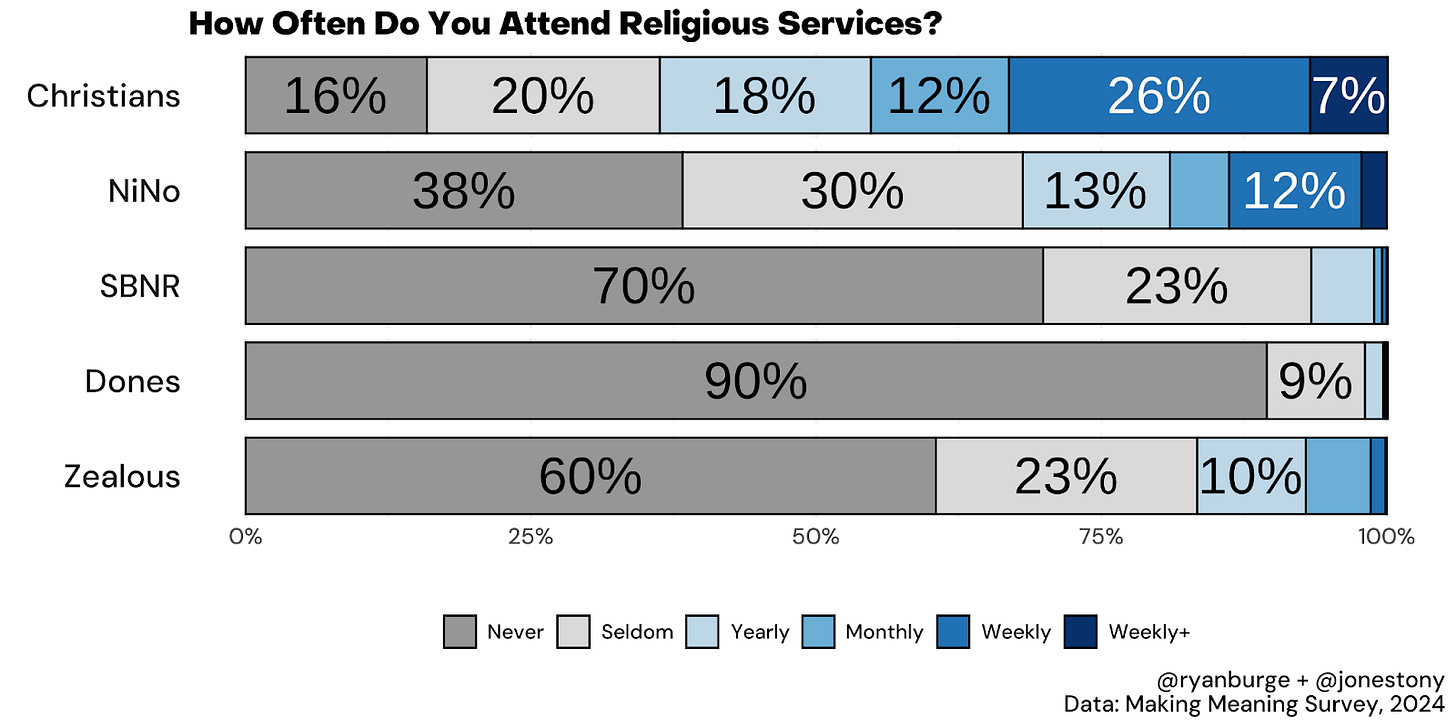
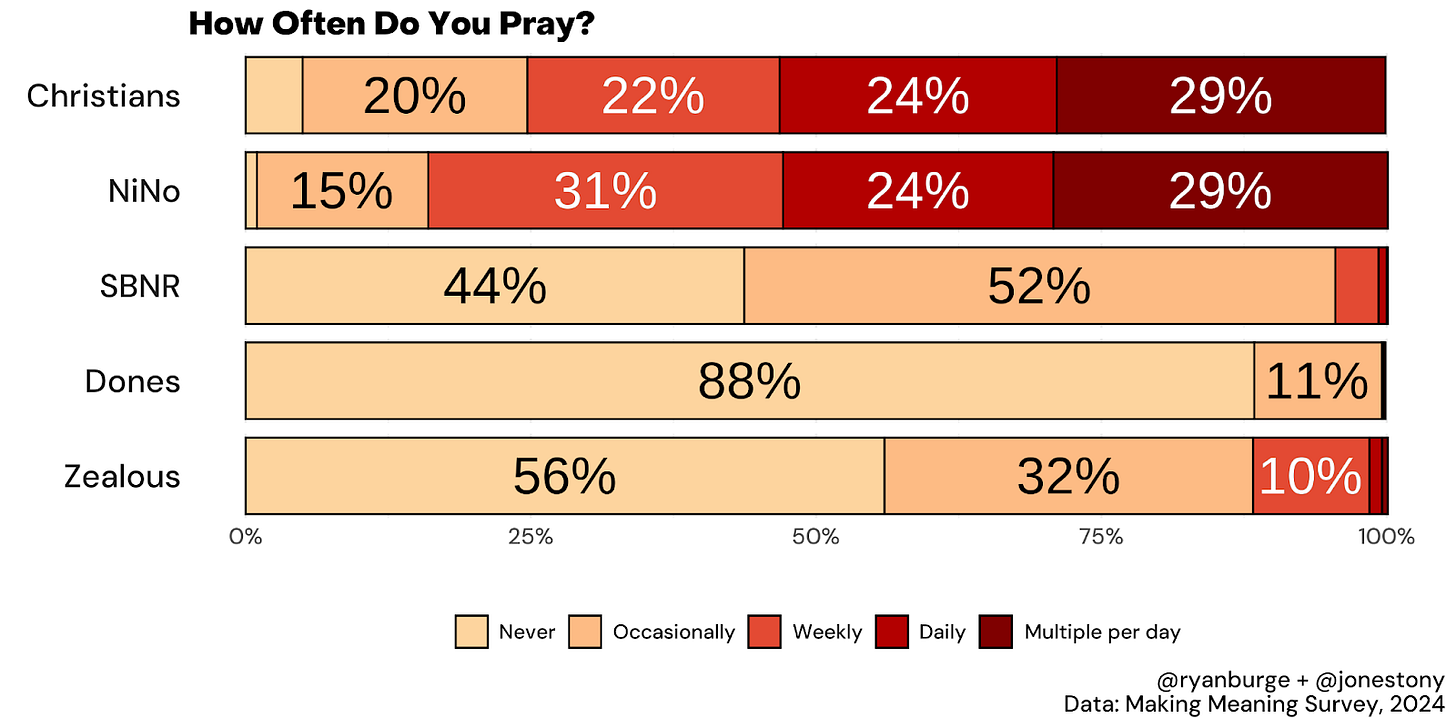
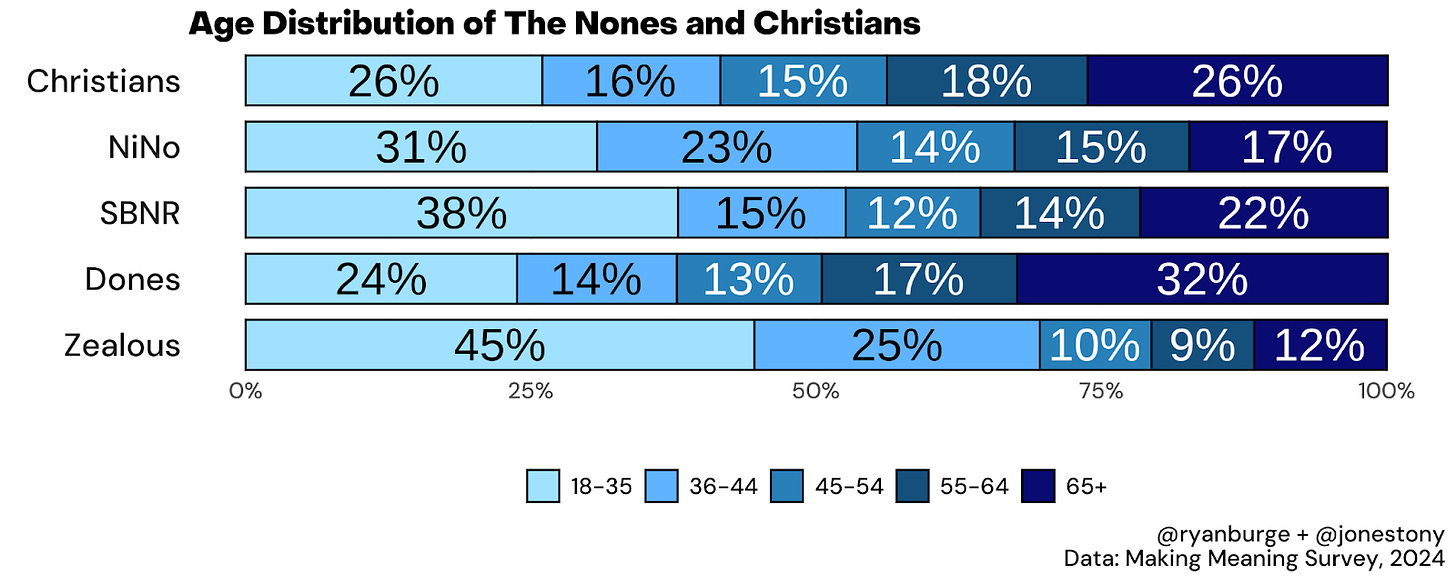


I wonder if the zealous have partners who would say religion is important to them and who attend with regularity. That would explain their passion—an ongoing dispute with a significant other.
What are the comparative numbers for zealous Christians?
Proselytizing (for or against) is something most Australians would never do, unless they belong to a church that demands it (JWs). I can only think of one Australian public figure who writes explicitly against religion, and he does so in such an avuncular fashion as to offend no-one
https://www.goodreads.com/book/show/17612232-adams-versus-god